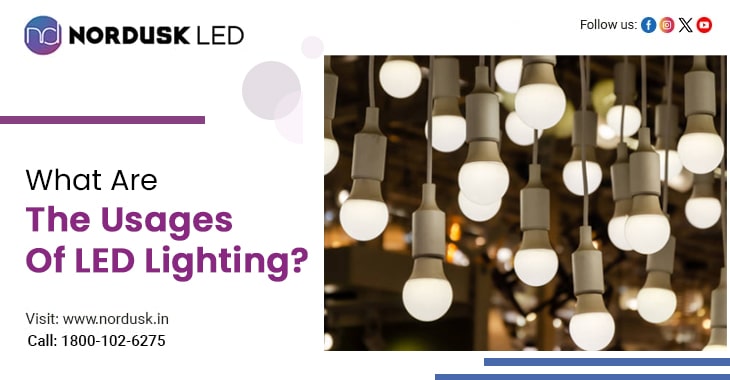What Are The Usages Of LED Lighting?
The lighting business has changed because of Light Emitting Diode (LED) technology, which provides a flexible and energy-efficient replacement for conventional lighting sources. LEDs are now widely used in many different applications, revolutionizing how areas are lit. If you must Buy LED Lighting Online, contact Nordusk LED. Here, you get the best quality lighting at affordable prices.
Let’s discuss the usages of LED:-
- Residential Lighting
- Commercial and Industrial Lighting
- Street and Outdoor Lighting
- Automotive Lighting
- Architectural Lighting
- Healthcare Lighting
- Horticultural Lighting
- Entertainment and Stage Lighting
- Retail Display Lighting
- Smart Lighting Systems
Residential Lighting:
LED lighting has taken the lead regarding home lighting options. Because LED bulbs come in various color temperatures, homeowners may use them to set moods in different spaces. Since LEDs last a long time and use little energy, they save a lot of money on energy costs while still providing reliable, excellent lighting for the entire house.
Commercial and Industrial Lighting:
Businesses and sectors greatly benefit from the adaptability of LED lighting. LED lighting fixtures provide bright, uniform illumination in commercial environments, including offices, retail stores, and warehouses, improving visibility and fostering a more productive work environment. Because LED light is directional, it can be used in retail settings to effectively spotlight or emphasize particular objects or focal points.
Street and Outdoor Lighting:
Because of its energy efficiency, extended lifespan, and directional light distribution, LED lighting is recommended for street and outdoor lighting. LED streetlights dramatically save energy usage and maintenance costs while improving road visibility and safety. Remote management also enables dynamic modifications to suit particular requirements, including dimming during off-peak hours.
Automotive Lighting:
LED lighting has revolutionized the car industry by providing more energy-efficient and brighter options. LED headlights improve motorist visibility and increase traffic safety. LED lighting is also utilized in turn signals, brake lights, and interior automobile lighting since it is more durable and responds faster than conventional incandescent bulbs.
Architectural Lighting:
With the advent of LED lighting, creative and dynamic lighting schemes are now possible in architecture. Architectural firms use LEDs to create visually striking effects by highlighting the elements of buildings, bridges, and landmarks. Controlling hue and intensity creates new avenues for creative and expressive architecture.
Healthcare Lighting:
LEDs have become more popular in healthcare settings where accurate and adaptable illumination is essential. By simulating natural daylight, LED lighting helps create a more relaxing and refreshing atmosphere for patients. Furthermore, some lighting conditions that facilitate medical procedures and improve the well-being of patients and healthcare personnel are created using color-tunable LEDs.
Horticultural Lighting:
LED technology has completely changed horticulture and indoor farming. LED grow lights stimulate healthier and more productive growth by giving plants the precise light wavelengths required for photosynthesis. Growers can cut energy usage and boost crop yields by optimizing conditions for different plant stages by customizing the light spectrum.
Entertainment and Stage Lighting:
LED lighting is a major component of the entertainment industry’s stage shows, concerts, and events. High brightness, a wide color gamut, and the capacity to produce dynamic lighting effects are all features of LED fixtures. They are perfect for prolonged use during performances because of their minimal heat output and energy efficiency.
Retail Display Lighting:
LED lighting is essential in retail settings where the presentation of products is very important. Because LEDs are flexible in terms of color temperature and intensity, businesses may design eye-catching and welcoming displays. LED light is directed, so there is less spilled light, keeping the item front and center.
Smart Lighting Systems:
LED lighting is becoming a crucial component of smart home systems because of the development of smart technology. Through smartphone apps, customers may remotely manage smart LED bulbs’ brightness, color, and scheduling. Controlling lighting with voice-activated assistants further improves lighting convenience and energy economy.
Conclusion
LED lighting finds wide-ranging applications that impact different facets of our everyday lives and enterprises. If you must Buy LED Lighting Online, contact Nordusk LED.

